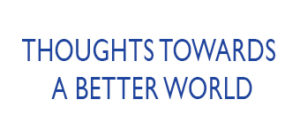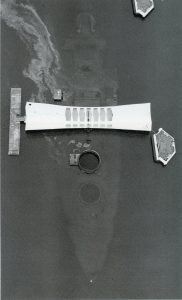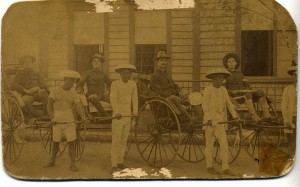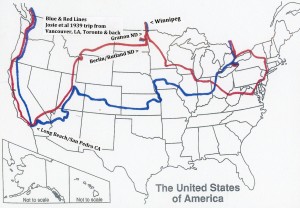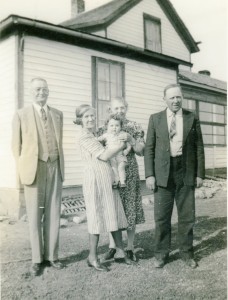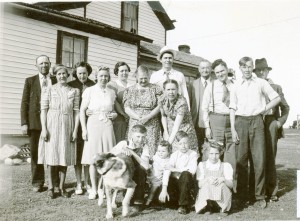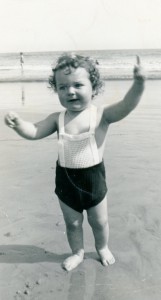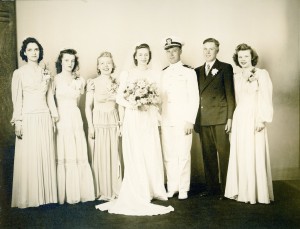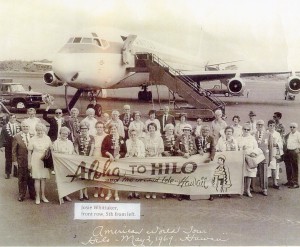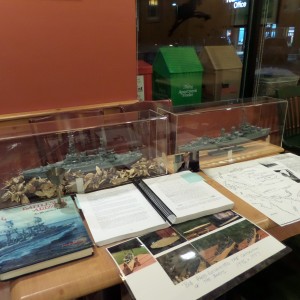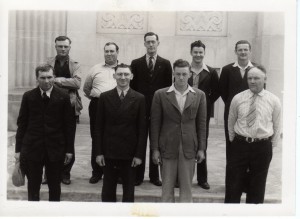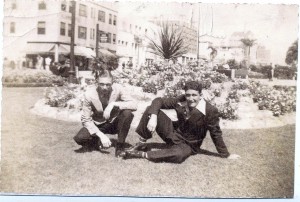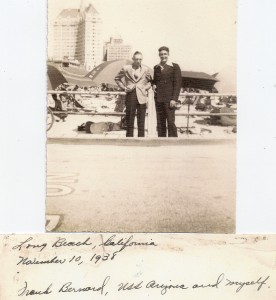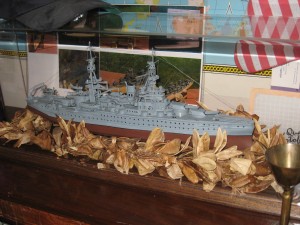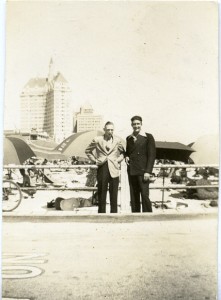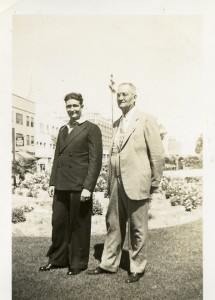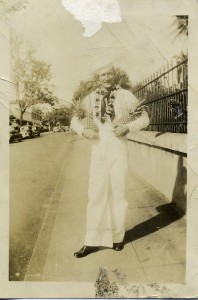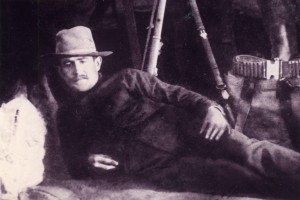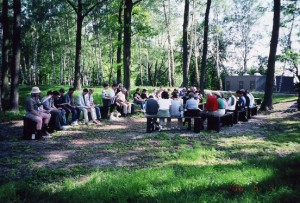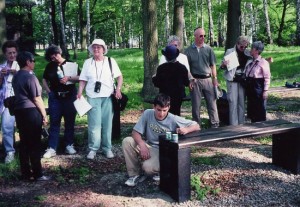The 75th Anniversary of Pearl Harbor: A Sailor and his Ship, the USS Arizona
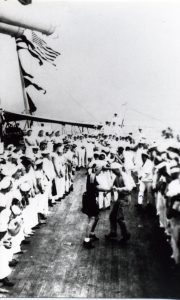
On the USS Arizona, sometime between 1936 and De. 7, 1941. Probably part of ritual of crossing the Equator for the first time. Photo likely taken by Frank Bernard.
You can easily determine the photographers location when he took the above photo by comparing with the following painting. (click to enlarge any illustrations).
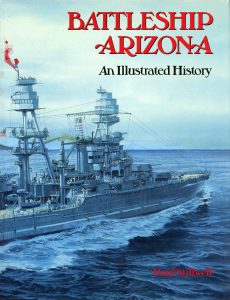
Book cover (see referemces below) The above photograph seems to have been taken on the foredeck of the Arizona.
I’ve written often about my Dad’s brother, my Uncle Frank Bernard, who perished on board the USS Arizona, Dec. 7, 1941. My reference link with his – and my – story is here.
In todays post, along with personal comments about Pearl Harbor, I revisit two aspects of the USS Arizona that I have not touched on before:
1) The intersection of the lives of Uncle Frank and the USS Arizona; and
2) reflections from a diver who was assigned to visit the Pearl Harbor grave of my Uncle and the 1176 of his shipmates who perished on-board December 7, 1941.
#1 and #2, below, come from a book I’ve had for 25 years: The Battleship Arizona, An Illustrated History, by Paul Stillwell, Naval Institute Press, Annapolis MD 1991.
The ship and its crew rest in peace. As I write, this date, there are only a very tiny number of survivors of Dec 7, 1941, still alive.
1) TWO LIVES, AS THEY MET AND MESHED: UNCLE FRANK BERNARD, AND THE USS ARIZONA, AND THEIR RELATIONSHIP TO HAWAII AND PEARL HARBOR:
(Info about 1936 forward from pp 323-332 of the Stillwell book)
24 July 1915 – Frank Bernard born in Grafton, North Dakota
12 October 1916 – USS Arizona commissioned at New York Navy Yard, Brooklyn.
4 September 1935 – Frank Bernard enlisted in U.S. Navy at Minneapolis MN; his home address 103 Wakeman Avenue, Grafton ND.
8 January 1936 – Frank Bernard transferred to the USS Arizona
15 July – 12 August, 1936 – Frank’s first visit to Pearl Harbor. (The Arizona had been to Hawaii, but only on two occasions, both in the 1920s. It’s previous locations were the western hemisphere, earlier primarily coastal U.S. Atlantic and Caribbean areas; in later years primarily west coast U.S. and Pacific, usually on maneuvers of one kind or another.)
1-4 April 1938 – (at Lahaina Roads. The brief link about Lahaina is interesting.)
8 – 21 April 1938 – Pearl Harbor
The Hawaii years, 1940-41.
10 April – 23 October 1940
(Alternated between Pearl Harbor (PH) and Lahaina Roads (LR)
10-25 April LR
26 April – May 13 – PH
14-23 May – LH
24 May – June 9 – PH
18-21 June – LR
22 June- 14 July – PH
15 July p August 1 – LR
2-19 August – PH
19-30 August – LR
30 August – September 5 – PH
5-9 September – LR
13-23 September – PH
(Most of next three months primarily at Bremerton/Puget Sound WA)
1941
3 February – 10 June PH*
* 17 June – 1 July at San Pedro. Reunion of Frank Bernard with the rest of the Bernard family at Long Beach CA June 22, 1941
8 July – 7 December PH
THOUGHTS FROM A DIVER WHO VISITED THE TOMB (from Battleship Arizona, Stillwell, pp 286-289).
“In 1983-84 Navy and National Park Service divers conducted an underwater archaeological survey of the wreck of the Arizona. The project, which was funded by the Arizona Memorial Museum Association, had several objectives…The results of the study have been published in a book [Submerged Cultural Resources Study] edited by Daniel J. Lenihan, principal investigator for the Submerged Cultural Resource Unit of the National Park Service.
[Interview by author Stillwell, 5 Mar 1990] One of the divers on the National Park Service team was Jim Delgado, and he was involved in a follow-up phase of the study in 1988. He has dived on a number of sunken ships, including the collection of naval vessels used for the atomic bomb tests at Bikini Atoll in 1946. Despite his considerable experience in the field, he explains that diving on the Arizona was something special. He compares it with being in the Oval Office of the White House or perhaps in Abraham Lincoln’s box at Ford’s Theater. He says that he and other divers did not want to enter the ship because they felt they would be trespassing in an area where they weren’t supposed to be.
When he was under the water, especially in the area where the Arizona’s galley used to be, he could look up and see the people watching him from the cutouts to the sides of the white memorial. As he swam around the submerged hull, he was reluctant to touch it or to look too closely into it. He had a eerie feeling that someone might look back from inside, even though reason obviously told him otherwise. He looked into a hatch and saw all sorts of marine growth and twisted metal choking the entrance, and he noted that the deck was covered with silt. Unexpectedly, something emerged from a hatch, startling him. When it floated into the light, Delgado saw that it was a globule of fuel oil, freed from the Arizona after nearly fifty years. It rose slowly to the top of the water, then spread out to produce a sheen on the surface.
While he was swimming underwater, Delgado was overcome by a sense of time warp. The world above had changed dramatically since 1941, including the building of the memorial. But the hull of the Arizona was largely the same as it had been after the magazine explosion had ripped her asunder. True, she was corroded and covered with marine growth, but the essence was still there – the same hull that had been built seven decades earlier in Brooklyn. Shining his light in through one porthole, he peered into Admiral Kidd’s cabin, which was largely undamaged. He saw heaps on the deck that could have been furniture. On a bulkhead was a telephone; Admiral Kidd had undoubtedly used it many times. Elsewhere he saw the tiles that had been the deck of the galley. On the deck were pieces of silverware and crockery, obvious evidence of human habitation many years earlier. He saw nothing that looked as if it have once been part of a man, and he was relieved not to.
When he swam near the bow, Delgado saw evidence of the cataclysmic explosion that tore the forward part of the Arizona apart. The decks were rippled. Pieces of steel appeared to have been crumpled as easily as if they had been made of paper. Beams and decks were twisted into grotesque shapes. The ship showed some evidence of damage aft, but the hull was largely intact – certainly in comparison with the bow. By the time he dived on the wreck, no ordnance was visible, although divers had seen some 5-inch projectiles earlier in the decade. Delgado and his fellow divers found no sign of the kind of large hole that a torpedo would have made in the side of the ship. When the Park Service divers/historian emerged from the grave of the Arizona, he was covered with oil and filled with a profound sense of having been close to something he calls a “temporal touchstone” because it has so much value now as part of the American culture….”
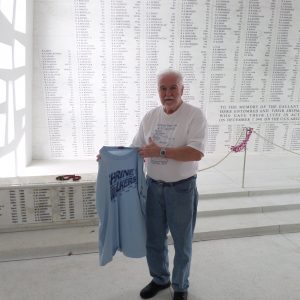
Dad visits his brother Dec. 18, 2015, represented by his son, Dick, and the blue t-shirt he used to wear when he went for long walks, and the Collette family reunion t-shirt (his mother was a Collette from Oakwood ND).
A PERSONAL REFLECTION: DECEMBER 7, 2016
This is what I know about my Uncle Frank Bernard: he was 26 years old when he died; he was quite a bit older than his fellow crew members. When he went into the Navy, it was, best of all, a job. It was during the Depression; he had been in Civilian Conservation Corps, and getting in the Navy was a good opportunity. He was a ship-fitter, which I understand was like a welder. He was unmarried, but had met someone, probably in Bremerton WA, who he apparently hoped to marry. She apparently was divorced, but I have never been able to learn who she was. He was a good sailor, from basic training on.
My uncle and the 1176 others who perished with him on the Arizona at Pearl Harbor were, I suppose, peace-time casualties – it wasn’t until the next day that war on Japan would be declared.
The men on the ship would have known about Hitler, and the war in Europe, and almost certainly knew that tensions between the U.S. and Japan had been building for many years. At the same time, it was quite clear that the attack on Pearl Harbor was one which was indeed a surprise, not known till the last minute. (I describe an excellent new book about this topic, here.)
I often think that Frank’s Dad, my Grandpa Henry Bernard, was unwittingly part of the history that led to the death of his son.
In 1898, likely in the fever of patriotism around the sinking of the Battleship Maine in Havana harbor, Grandpa and others from the Grafton ND area were among the first ND volunteers to enlist for the Spanish-American War. He and his ND Company spent a year, 1898-99, in the Philippines, which became America’s outpost in what the Japanese considered their sphere of influence. While among the first troops to arrive at Manila, the Spanish had basically already been defeated, and most of their time was spent fighting Filipinos who’d just as soon see the U.S. go home. The company lost four men in battle at Pagsanjan Falls, near Paete, Luzon.
Tour over, in 1899, Grandpa and the crew stopped in Yokahama enroute home from Manila (picture at end of this article). It is a picture that speaks a million words.
By late 1941, war planners thought that the Philippines would be a more likely target than Hawaii for the Japanese.
After the attack:
On Dec. 6, 1941, those on the Arizona and elsewhere at Pearl Harbor, would have had no idea about the deadly four years to come; about 50 million dead in WWII, hundreds of thousands of these, Americans; the Holocaust; the Atomic bomb….
The great prospect of peace which came with the founding of the United Nations in 1945; then the endless wars which someone always declares are necessary, but which never really resolve anything. Each war, it seems, provides a pretext for the next war.
In my opinion, for we, the living, is that the next big war, if it comes, carries the prospect of ending civilization as we have come to know it. Nonetheless, someone will be tempted to “pull the trigger”. It matters who leads.
Our nation’s default setting through almost all of its history has been achievement of power through war. War is what basically built our country; and it is war that expanded our empire to an unimaginable and unmanageable extent.
War brought prosperity; it could as easily bring defeat. There is evil; there will always be war. But we need to guard against war as the first and only solution to problems.
The illusion now sold is that we can again be as we were: the very premise of “Make America Great Again”.
It is a proposition doomed to fail. It can only be achieved at someone else’s expense, which simply ramps up anger and the desire for revenge.
We need to change our national conversation, one conversation at a time.
The solution…or the problem…lies in each one of our hands.
Our future depends on each of us.
Here are a couple of items to possibly help give definition to the years since 1941:
1. A personal compilation of American War Deaths over history: War Deaths U.S.002
2. America at War (from the American Legion magazine): America at War001
(The first is only about American war deaths, simply to help me get some personal definition of the changing problem; but the reality is that we, and many others, now possess the capacity to destabilize and destroy everything…as could have happened had cooler leadership heads not have prevailed in the Cuban Missile Crisis in 1962.)
Also, take 30 minutes to watch the 1971 film entitled Man’s Next Giant Leap. It was produced by my friend Lynn Elling, Naval officer in WWII and businessman, who died some months ago at 94. It can be accessed here. The people who put this film together, business and civic and political leaders, Republican and Democrat, believed in the possibility of peace, and they can be examples for us to follow.
As the hymn goes: “Let there be peace on earth, and let it begin with me.”
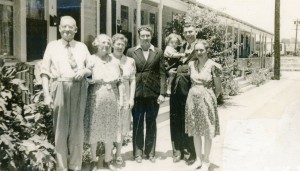
The family members in the story are, at right: Richard, Henry and Esther Bernard. From left, Henry and Josephine Bernard, Josie Whitaker, and Frank Bernard, Henry’s parents and siblings, in Long Beach June 22, 1941.
COMMENT:
from Annelee: I read Uncle Frank, When will we learn? However, War with Japan and Germany were justifiable.
Response from Dick: There is no question that war was “justifiable” in both instances. However, I do have a couple of points.
First, it has long been my contention that America waited far too long before entering WWII, which began two years before Pearl Harbor. As a country, we were isolationist, and there were other complications such as a – let’s be honest – not terribly friendly attitude towards the Jews, and an otherwise close relationship with Germany in all senses of the word.
Second, I am always interested in when history is deemed to begin. Pearl Harbor didn’t begin our history of relationship with Japan, for instance. We were sowing the seeds long before. My Grandpa and his fellow soldiers enlisted, I’m pretty sure, to support defeating Spain, with the battle cry “Remember the Maine”, but their service was far from Cuba, in the Philippines on the island of Luzon (Manila). The Spanish-American War was Teddy Roosevelt’s war, largely, supported by the Press, and it seems to have been a war of acquisition, not defense. In the end analysis, it really had little to do with Spain, and more to do with American expansion, and in the case of Japan, what became “our” Philippines was within their sphere of influence, and far closer to them than Hawaii. Like us, they apparently had pretenses of power, and we were boxing them in.
Plus, we long had a very dismissive attitude about the Japanese, generally. People my age who grew up in the United States remember things purchased from Japan which were more in the curio class than anything else. “Japan” was a synonym for “cheap”.
Japan and some other places might now be jewels of capitalism, but at what cost in lives in WWII? I think we have a big blindspot in this area, and we’ll find out if we try to “Make America Great Again” the cost of national pride at the expense of others.
A concluding comment: As I write I remember that letter in German written by my Great Uncle in Dubuque IA Feb. 14, 1924 to his relatives in Westphalia (borderland of today’s Netherlands). At the time of his letter, he’d lived in the United States for over 60 years. In a very long sentence, which the translator described as emotion laden, he remembered a slaughter day conversation from perhaps 1850, and comments his grandmother made about the French during the time in the early 1800s when Napoleon had designs on controlling Europe.
He said this: “I will never forget how, each year on slaughter day, as we cut the fat pigs and cows apart, dear grandmother would say if only the dear Lord will let us eat it in peace and good health, and then, each time, she would tell how the French took everything of hers, in addition to all of the oppression they had to endure, and dear grandfather would tell how the French and the Russians took him and his father with (their) horses and wagon to drive under orders for weeks and, how the horses couldn’t go anymore, and how they were then whipped and left by the wayside (to die) and that the Busch’s homestead had been their lawful property but was taken away by the French, no wonder that my father left his home with his sons [for America]. France’s history has always been full of war and revolution for the last three hundred years and Germany was always the oppressed, if they will ever become peaceful?”
The phrase, “you lost, get over it”, takes on new meaning with this very long emotion filled sentence.
